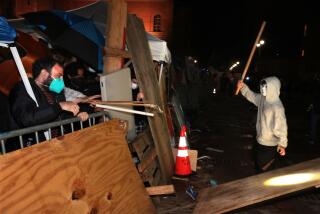COMMENTARY ON JOURNALISM : Riots Provided New Outlook on Relation of Race to Reporting : Ability should be the key, but a black newsman found that his color mattered on the streets of L.A.
As a black reporter in a largely white county, I have run into few instances when my toffee-colored skin has hindered my ability to gather the news. But I see how things can be quite different in the metropolis to the north, an expansive amalgam of hues and tongues called Los Angeles. There, the color of my skin did make a notable difference in how I could do my job.
But this irony did not become clear until after a week of reporting on the anger and pain that exploded in the aftermath of the Rodney G. King beating case.
Something else was crowding my thoughts on the first night of rioting.
As I rushed into the chaotic, burning city hours after the verdicts were read, I couldn’t shake the feeling I was chosen to go, in part, because I am black. And I couldn’t let that keep me from covering one of the biggest stories of my life.
Before that assignment, I firmly believed it would be wrong to let a reporter’s race be a factor in deciding who covers a story.
Seven days of reporting on the civil unrest and its aftermath shook that conviction. Yet as someone who is trying to succeed in journalism as a reporter, not as a black reporter, my feelings remain unresolved.
Leaving the Orange County newsroom last April, I pushed that debate to the back of my mind as I scooped up extra note pads and pens, checked for my police-issued press pass and acknowledged advice to “keep your head low.” I was one of a racially mixed group of reporters, men and women, sent that week from the Orange County Edition to assist with riot coverage.
Little more than an hour later, I was on Arlington Avenue, one of the explosive front lines of the violent and sometimes murderous uprising. The streets were a threatening place for anyone, but twice the first night I believe my color helped me avoid trouble.
At 54th Street and Arlington Avenue, I took my place with several other reporters around a city bus terminal converted into an emergency staging area for police units and fire trucks.
I was listening in as Pastor John McCoy of Inglewood’s Maranatha Seventh-day Adventist Church gave an interview to a white television reporter. McCoy stopped abruptly in mid-sentence as a black man passing by confronted the reporter.
“Excuse me! Excuse me!” the man yelled, sending the reporter bending backward. “Why don’t you get out of here? Why are you people only down here when black folks are in trouble?” McCoy turned to the man, urging him to calm down and leave.
The passerby, who was outraged that the mainstream press was in his neighborhood, seemed to look past me, even though the yellow press pass clipped to my shirt and notebook in my hand announced my status. My complexion shielded me from the wrath vented on the white reporter, who was seen as an outsider exploiting the situation.
But I stood there too, drawn by the same professional code. Only in the bystander’s eyes, I had more credibility.
I spent the early hours of the next day outside an Inglewood hospital. Doctors frantically stitched and patched dozens of wounded men, several of whom appeared to be gang members. Many were brought to the hospital by their homeboys, who now waited outside. Several reporters and I attempted to question them about the riots.
The three white reporters standing with me got in-your-face looks as the gangbangers flashed gang signs and shouted out an earful of challenges. While they did not answer my questions, the gangbangers did not harangue me.
When the riots were quelled and multi-ethnic brigades began cleaning some neighborhoods, I went to some of the worst-hit areas.
In Compton, I had just finished an interview with Bob Davis, the black owner of Sound City Records, when he told me one more thing: “Hey, it’s young brothers like you who are going to help pull this thing back together.” I shook his hand and thanked him for his time.
I began to see how my color in Los Angeles--just like my knowledge of Spanish in Orange County--was serving as a pass that helped me better report on the central city.
Nevertheless, just a few blocks from Davis’ shop I was reminded that this easy analysis would not stand in the face of the troubling racial issues pushed to the fore by the riots.
A black teen-ager practicing the drums with a school band refused to talk to me, saying I was an “outsider,” and sent me off with angry eyes.
I thought back to a black looter on Vermont Avenue who waved me away with a new pair of sneakers, saying he wouldn’t talk to people from “that white paper.”
And then I began hearing the stories from other reporters. Some black reporters and photographers had pistols waved in their faces or had to duck bullets, just like their white colleagues.
The complexities of the L.A. riots and their aftermath continue unraveling for a turbulent city and for me.
While Los Angeles searches for ways to rebuild after the rioting, my personal debate over the role a reporter’s race should play when stories are assigned is not any clearer. I saw that while race mattered on one street corner, on another it didn’t.
Ideally, though, in the workplace and elsewhere, ability, not race, will be the measuring stick.
More to Read
Sign up for Essential California
The most important California stories and recommendations in your inbox every morning.
You may occasionally receive promotional content from the Los Angeles Times.










